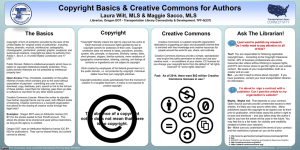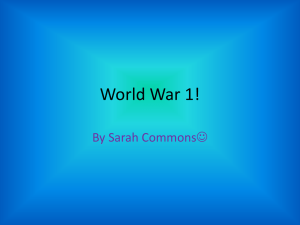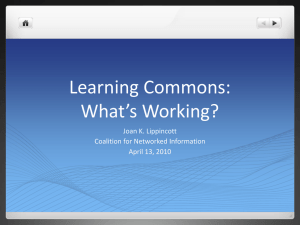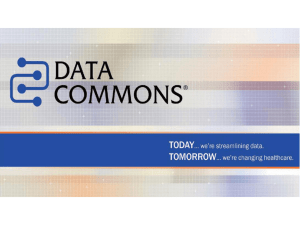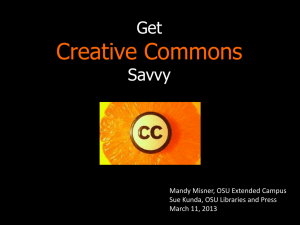`Library Commons`?
advertisement
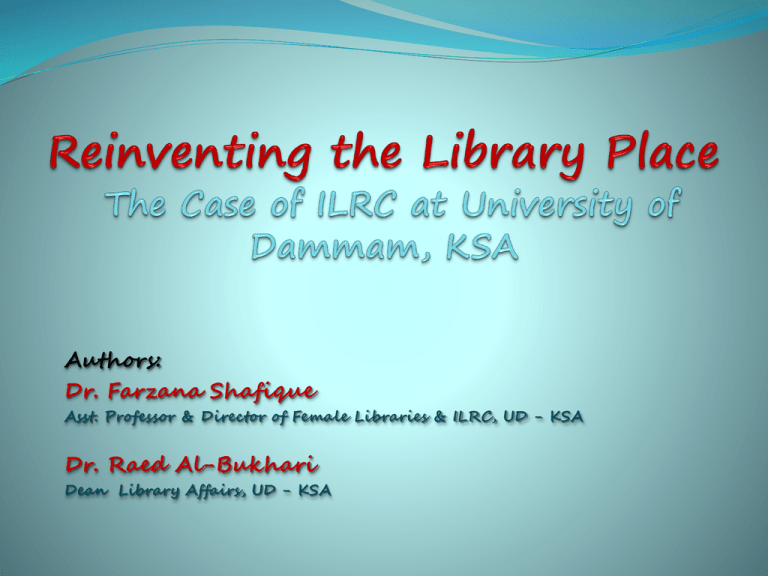
Authors: Dr. Farzana Shafique Asst. Professor & Director of Female Libraries & ILRC, UD - KSA Dr. Raed Al-Bukhari Dean Library Affairs, UD - KSA Contents Background Objectives Methods Our Context Conclusions Background of the Study What is the ‘Library Commons’? Commons are resource domains in which common pool resources are found (Buck, 1998). In the old days, the “village commons” was traditionally a place to graze livestock, stage a festival, to sell the domestic items, to hold the public meetings or to meet the neighbors. This concept of social utility underlies the philosophy of the modern library commons, which is a flexible environment built to accommodate multiple learning activities(EDUCAUSE, 2011). Cont… This concept of social utility underlies the philosophy of the modern library commons, which is a flexible environment built to accommodate multiple learning activities(EDUCAUSE, 2011). Cont… Thus, the library commons is a ‘place’ where students have access to library resources, productivity software, areas to work individually or in groups, reference assistance and technical support to research and produce projects under one roof (Kent & McLennan, 2007). Why Do we Need a Library Commons? The Library Commons have established themselves as a place where students come to engage in collaborative learning by providing the spaces, technologies, information resources, and expert assistance to support that learning. It brings together the functions of libraries, labs, lounges, and seminar areas in a single community gathering place. This face-to-face forum supports the sharing of student ideas outside the classroom, complementing the shift in pedagogy toward collaborative media and team efforts. Four Stages of Change According to Beagle (2004), a transition from information to learning and research commons depends on four stages, such as the adjustment; isolated change; far-reaching change; transformation. Methods Methods Used This presentation aims at sharing a good practice at UD library; This is not a research paper; however, ideas expressed here are based on: Review of Literature; Review of local users’ needs and cultural values; Virtual or physical visits to library commons; Discussion with experts; Personal creativity Our Context Our Context Keeping the importance of the Library Commons in view, the Deanship of Library Affairs at University of Dammam has decided to establish a library commons at UD. As a guiding theory, it has adopted the guidelines of Beagle for establishing its library commons. In this perspective, the Deanship has made necessary arrangements for the first two stages of adjustment and isolated change by making necessary changes in the environment and by providing needed tools and technologies. And now the Deanship of Library Affairs has the dream of achieving the next two stages i.e., far-reaching change; and transformation. Goals/Objectives of the ILRC: To provide customized, expert assisted, and user- centered access to information through print books/journals, online resources and ILRC help desks; To cultivate the collaborative, ethical and lifelong learning values among students, staff, and faculty; To proliferate highest quality scientific research, innovation and development culture at UD; To compete and lead the World with advanced 21st Century skills and technological tools. Our Definition of the ILRC “The Deanship of Library Affairs, University of Dammam has decided to develop an Information, Learning & Research Commons (ILRC). The name ILRC denotes to different commons zones characterized with different objectives, activities and noise levels….”. Different Zones of the ILRC Green Zone (Collaborative Learning Commons); Yellow Zone (Information Commons); Red Zone (Research Commons); Cafe Zone Green Zone (Collaborative Learning Commons) Collaborative Learning zone Open Discussions Group Presentations Book the place for your presentation Medium level of noise is allowed Cell Phones are allowed Wall mounted/or portable large LCD Screens Computers for collaborative learning or individual use White board for collaborative teaching/learning among student groups/peers Use of iBrainstorm/Endnote/Blackboard software White board marker and duster can be issued on UD ID. Yellow Zone (Information Commons) Only low level noise is allowed + No Cell phone Small group studies are allowed with low level noise Study Carrels for individual study Multipurpose Help Desk (Reference and Information Help, IT Help, E-learning Help, Language/Writing Help Get Research Commons membership + Make an Appointment for Research and Learning commons services + make a booking for CLZ/TCZ + get registered for a course OPACs (at-least 3 PCs) E-scanning Services + Self Check-in Check-out Service Sofa sitting for relaxed study Issuance Desk of material for learning commons (white board markers, dusters, i-pads/laptops). LCD Screens on Group study tables. Red Zone (Research Commons) No talking + No Cell Phones Only members of Research Commons can use the service Mandatory research production by the members Make an appointment for getting orientation about services of Research Commons Research classes/courses/ research supervision/coaching (scheduled classes on Tuesday) Computers/smart board/white board/important research related resources/books Referencing & copyright training trough Turn-it-in and EndNote Advanced Certificate Courses (arranged locally or in collaboration) Attendance of the users on daily bases Photocopying/printing/scanning facility Reserve the space for your lectures/workshops (reservation is allowed for faculty only). Cafe Zone Eating and Drinking is allowed (student will wipe the table after eating and drinking) Smart tables and chairs Cold Drink vending machine Cell Phone calling/listening is allowed Which services are offered??? Services offered by ILRC Technology Help; Information Resource and Online Searching Help; Intensive Research Help; help in study design/research methodology, statistical analysis, using SPSS...etc. Laptop/ipad/e-tab checkout facility; Library/ILRC Minutes: every week new bulletin will be prepared in the form of news clips or videos for displaying on screens of different spots; Thinkers’ café = with Idea Playground Screens; Register your workshop/collaborative learning/discussion topics along with reserving the space; Virtual Space for ILRC services; Services … Use of Commons Spaces for teaching and learning with peers; Availability of Private carrels for PhD students, researchers and faculty; Registration for multiple ILRC services Use of Media Lab for idea generation and presentation through video making; Referencing Training: Bibliographical citation management training Use of End-Note (Web and Desktop versions); Copyright Training: Copyright material policy Academic honesty and preventing plagiarism; Use of Turnitin Detection and prevention of plagiarism; Development of student writing skills. What are our Policies? All the services and facilities of the ILRC can be used under the defined policies. The policies are related to: Membership of the Research Commons; Reservation of Collaborative Learning Zones for group study; Registration for workshops/seminars etc.; Lending of Laptops/i-pads/e-tabs; Reserving the media lab and resources for seminars/workshops by the faculty; Food and beverage within the ILRC; Equipment damage or overdue fines/penalties. How We Will Evaluate the performance of ILRC? It is also important to evaluate the outcomes of resources and efforts of the ILRC. In practice, there are two types of surveys: a) In-person Surveys; b) In-class Surveys. In-person Surveys: Services used in the Commons on a typical visit. In-class Surveys: Use of Commons services and spaces or feelings about the value of the Commons and their experience of the place. So, UD has decided to use both types of survey for evaluating the performance of its ILRC. Conclusions Conclusions… It is concluded with the feeling of pleasure and excitement that with the planning and establishment of the ILRC at UD, the library and information professionals have opened the doors of new services at the university. This innovation has been appreciated by the UD community at large and has given a remarkable respect to the library and information professionals. Cont… However, still this ILRC is in its infancy. When the principal author is sharing this experience, it has been very recently implemented at female campus, while it is in implementation phase at male campus of UD. Cont… It is strongly believed that if implemented truly, it would change the learning, research and scholarship landscape not only within the university but within the region. Thanks for your patience References Beagle, D. (2004) ’From Information Commons to Learning Commons.’ Information Commons: Learning Space Beyond the Classroom. California. Buck, S. J. (1998). The global commons: an introduction. Island Press: Washington, DC. EDUCAUSE . (2011). Things you should know about: The modern learning commons. Retrieved June 14, 2013, from: http://net.educause.edu/ir/library/pdf/eli7071.pdf Kent, P. G. & McLennan, B. (2007). Developing a Sustainable Staffing Model for the Learning Commons: The Victoria University Experience.Paper delivered at the International Conference on Information and Learning Commons: Enhancing its Role in Academic Learning and Collaboration, The Hong Kong University of Science and Technology Library. 10 – 11 December 2007.
